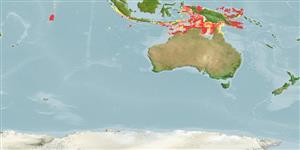Common names from other countries
>
Eupercaria/misc (Various families in series Eupercaria) >
Caesionidae (Fusiliers) > Caesioninae
Etymology: Pterocaesio: Greek, pteron = wing, fin + Latin, caesius = blue grey (Ref. 45335).
Environment: milieu / climate zone / depth range / distribution range
Ecologia
marinhas associadas(os) a recifes; não migratória; intervalo de profundidade 0 - 50 m (Ref. 90102). Tropical; 0°S - 15°S, 68°E - 154°E (Ref. 402)
Indian Ocean: Chagos Archipelago to Christmas and Cocos-Keeling islands. Western Central Pacific: Papua New Guinea, Philippines (Ref. 43437, 53416, 57038, 59110). Reports from the Comoros in western Indian Ocean (Ref. 4517) is being confirmed.
Tamanho / Peso / Idade
Maturity: Lm ? range ? - ? cm
Max length : 23.0 cm TL macho/indeterminado; (Ref. 90102); common length : 11.4 cm SL macho/indeterminado; (Ref. 37816)
Espinhos dorsais (total) : 10; Raios dorsais moles (total) : 14 - 16; Espinhos anais: 3; Raios anais moles: 12 - 13. Body bluish or reddish dorsally, lighter ventrally. 4-5 cheek scales; 23-30 predorsal scales; scaled dorsal and anal fins; confluent Supra-temporal band of scales at dorsal midline. Upper peduncular scale rows 12-14; lower peduncular scale rows usually 16-17 (15-17). Post maxillary processes 2; posterior end of maxilla tapered. A small flat process on either side of ventrolateral surface of basioccipital, projection not ventrally far from ventral rim of condyle (Ref. 1723). Caudal fin lobes with dark tips. Head length 3.1-3.7 in SL; body depth 4.1-5.3 in SL (Ref. 90102).
Inhabits coastal, lagoon, and seaward areas around coral reefs (Ref. 90102). Feeds on zooplankton in midwater aggregations. Oviparous, with numerous, small pelagic eggs (Ref. 402). Maximum length observed in the field estimated at about 20-25 cm TL (Ref. 74965).
Life cycle and mating behavior
Maturities | Reprodução | Spawnings | Egg(s) | Fecundities | Larvas
Carpenter, K.E., 1987. Revision of the Indo-Pacific fish family Caesionidae (Lutjanoidea), with descriptions of five new species. Indo-Pac. Fish. (15):56 p. (Ref. 1723)
Categoria na Lista Vermelha da IUCN (Ref. 130435)
CITES (Ref. 128078)
Not Evaluated
Ameaça para o homem
Harmless
Utilização humana
Pescarias: pescarias de subsistência
Ferramentas
Relatórios especiais
Descarregue XML
Fontes da internet
Estimates based on models
Preferred temperature (Ref.
115969): 27.2 - 29, mean 27.9 (based on 128 cells).
Phylogenetic diversity index (Ref.
82804): PD
50 = 0.5002 [Uniqueness, from 0.5 = low to 2.0 = high].
Bayesian length-weight: a=0.01072 (0.00467 - 0.02458), b=3.12 (2.94 - 3.30), in cm Total Length, based on LWR estimates for this Genus-body shape (Ref.
93245).
Nível Trófico (Ref.
69278): 3.4 ±0.45 se; based on food items.
Resiliência (Ref.
120179): Elevada, tempo mínimo de duplicação da população menor que 15 meses (Preliminary K or Fecundity.).
Fishing Vulnerability (Ref.
59153): Low vulnerability (13 of 100).
